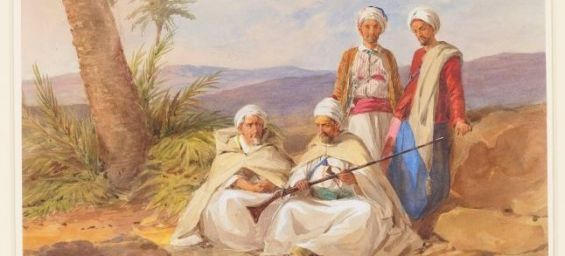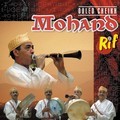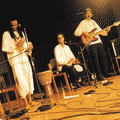Queen Victoria of the United Kingdom and her husband Prince Albert were fascinated with immortalizing the places they had visited and events they had attended. They owned souvenir albums that they carefully collected as visual journals, with watercolors of all their special memories and encounters.
The drawings were arranged chronically and captioned by the royal couple themselves. One of the paintings featured on the Queen’s special souvenir albums was that of four Moroccan men.
They are Hadj Abdullah Lamartz, Kaid Abdelkrim, Hassan Boocheta and Boojmar, who sailed to England in 1850 to deliver the precious presents of the Sultan of Morocco to his Western ally Queen Victoria.
Four Moroccan men at Buckingham Palace
The pencil and watercolor painting shows two men seated on the ground and two others standing behind them in a landscape, that refers to Morocco, their country of origin. The drawing by British watercolorist John Absolon pictures the two men seated next to a palm tree, with one of them holding a long and ancient Moroccan rifle.
The two men are dressed in white jellabas, with off-white wool burnusses on their shoulders. The man with the rifle has his waist wrapped in a greenish built and a blue over-the-shoulder string that held his sheathed dagger. Both are bearded, mature men, one of which is looking down, while the other is looking afar.
While sitting, two other men are standing behind with more colorful clothing. Wearing white turbans, yellow, red and blue pieces, they appear to be of a lesser ranking than the two other men seated on the ground.
Titled «The bearers of presents to the Queen from the Sultan of Morocco 1850» by the Royal Collection Trust, the painting is indeed meant to immortalize the informative title. Hadj Abdellah Lamartz is described as a «tall, well-made and very intelligent man», and Hassan Boucheta as an independent merchant trading between Tangier and Gibraltar, Kaid Abdelkrim, as an athletic man of sinew and the soldier attached to the British Consulate at Tangier and Boojmar, the groom of the consulate. All were sent to present the gifts sent by the court of Sultan Abdurahman to the Queen.
«A lion, nine horses, a panther, four ostriches and six gazelles», captioned the painting commissioned by the Queen and originally mounted in Souvenir Album V. The wild animals, in addition to the meek ones were sent to the Queen as a sign of gratitude by Moulay Abderrahman after he «had received excellent medical treatment in Gibralter through the British Government», reads a description of the painting.
Moroccan horsemanship
On April 9, Queen Victoria visited the Zoological Gardens in Regents Park to see the Moroccan ostriches. The Queen called the birds «beautiful and immense».
Shortly after, and alongside Prince Albert and younger members of the Royal family, the Queen inspected the other presents sent by the Sultan of Morocco. On April 20th, the Queen saw the nine horses dressed with saddles.
The following day, three of the horses were inspected in the Riding School, with Hadj Abdellah and Kaid Abdelkrim. Together with a groom, they «exhibited feats of horsemanship with which the Queen and the Prince and the younger members of the Royal Family were much gratified», reads «The Royal Princesses of England» by Matthew Hall.
The feats took place at Epsom according to another source, which indicates that the Moroccan guests rode the horses, and the Queen picked a winner. «They were engaged to appear for the fifth time in the presence of the Queen; but her Majesty graciously dispersed with their attendance, in order that they might witness the sport, which they did; and from their knowledge of horse flesh, picked out as the winner the horse that eventually came in second».
During their visit to England, the four men visited London and were taken to Windsor. They were also received by the Queen at Buckingham Palace and sketched by her in her journal.
Queen Victoria later asked Absolon to draw a portrait for the four Moroccan men to include in her Souvenir Albums. And so it was, the four men are forever remembered for their mission, attesting of Moroccan diplomacy, fashion and horsemanship.





 chargement...
chargement...












